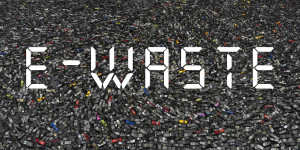Electronic waste, or e-waste, is a term for electronic products that have become unwanted, non-working or obsolete, and have essentially reached the end of their useful life. Because technology advances at such a high rate, many electronic devices become “trash” after a few short years of use. Thus, computers, cell phones, radio sets, refrigerators etc constitute e-waste. These items produce complicated multi-material waste with different proportions of metals, plastics and glass. They can be polluting if they are not adequately treated before disposal.
With the high demand for these electronic products Nigeria has literally been turned into an international dump site for all manner of electronic junk. A certain report published by the U.S. – based “San Diego Tribune” newspaper on December 2, 2005 reveals that up to 80 percent of electronic waste generated in the United States meant for recycling is quietly exported to other countries. These include some 350 million computers in use in the U.S. which are fast becoming obsolete.
Obsolete electronic devices are rapidly filling landfills across the globe. In the US alone, more than 100 million computers are thrown away with less than 20% being recycled properly. The EPA estimates as much as 60 million metric tons enter landfills every year.
But these products are not entirely useless as several parts can be recycled to very useful products. A recent report by Aljazeera which spotlights a Bolivian teenager turning e-waste into robots supports this and Kodjo Afate Gnikou, a resourceful inventor from Togo in West Africa, has made a $100 3D printer which he constructed from parts he scrounged from broken scanners, computers, printers and other e-waste.
What then is the proper way to recycle e-Waste?
Solving the e-waste problem starts with education, and habit changes as a result of knowledge. Most people are trained to recycle a newspaper, bottles, and cans. Almost anything electronic in nature can be recycled properly with effort. Some countries have transfer stations that accept e-waste for recycling. It is important to ensure that e-waste processors are fully certified in safe disposal of electronic waste.
Most electronic waste goes through a recycling system called a WEEE (Waste Electrical and Electronic Equipment), which not only recycles 95-98%, by weight, of all e-waste passed through it, but ensures that any data left on hard drives and memories are thoroughly destroyed too.
E-waste Recycling Process
Picking Shed – first all the items are sorted by hand and batteries and copper are extracted for quality control.
Initial Size Reduction Process – items are shredded into pieces as small as 100mm to prepare the e-waste for thorough sorting. This is also where the data destruction takes place.
Secondary Size Reduction – the small debris is shaken to ensure that it is evenly spread out on the conveyor belt, before it gets broken down even more. Any dust extracted is disposed of in an environmentally friendly way.
Overband Magnet – using magnets, steel and iron are removed from the debris.
Metallic & Non-Metallic Content – aluminium, copper and brass are separated from the non-metallic content. The metallic can then be reused and resold as raw materials.
Water Separation – water is used to separate plastic from the glass content. Once divided all raw materials can then be resold.
Culled from
http://www.calrecycle.ca.gov/electronics/whatisewaste/
http://www.iccon.org.ng/index.php?option=com_content&task=view&id=192&Itemid=29
http://www.ewaste.com.au/ewaste-articles/how-is-electronic-waste-recycled/
http://inhabitat.com/west-african-inventor-makes-a-100-3d-printer-from-e-waste/
http://www.andreweusebio.com/writingresearch/electronicwaste


